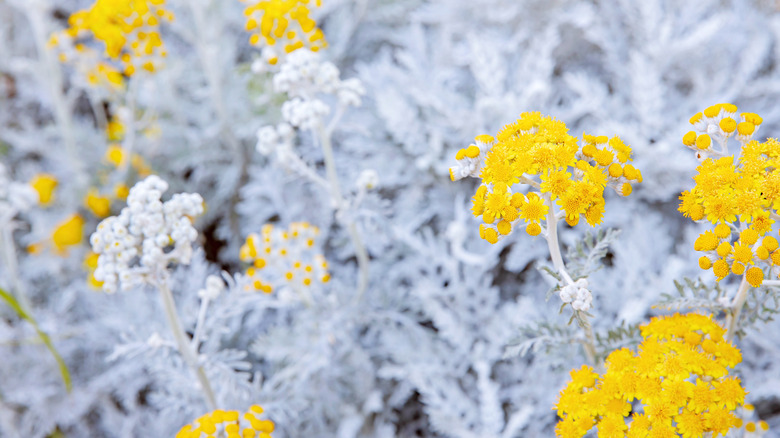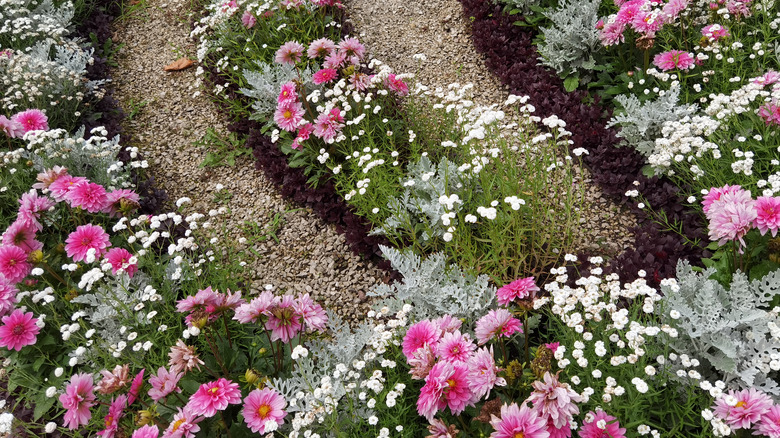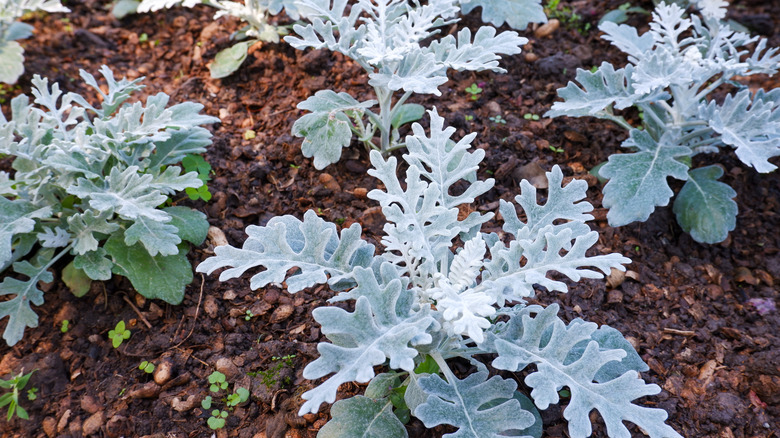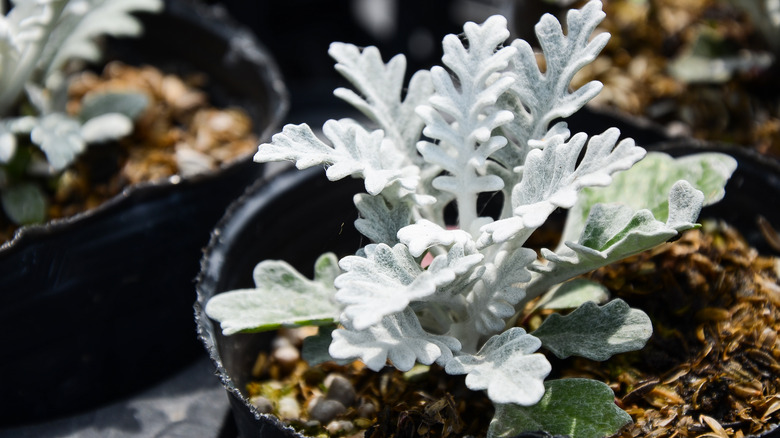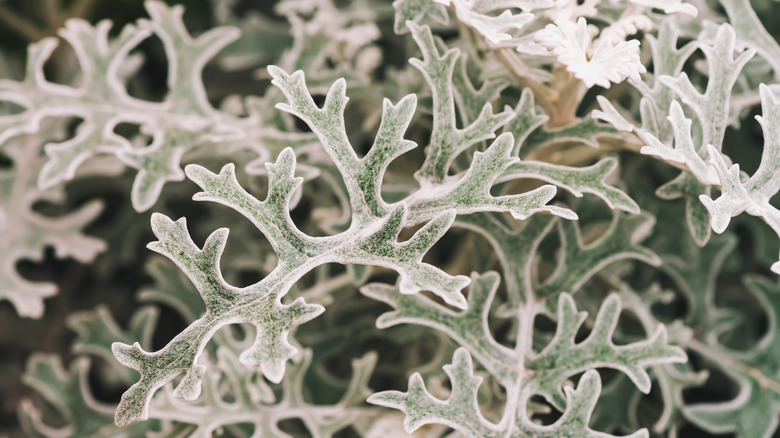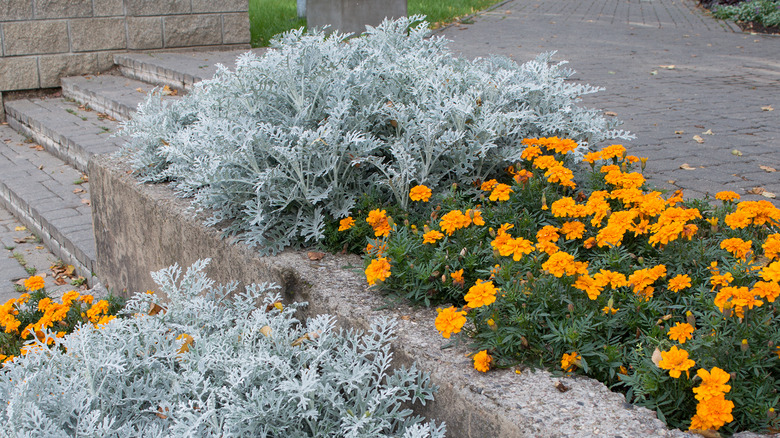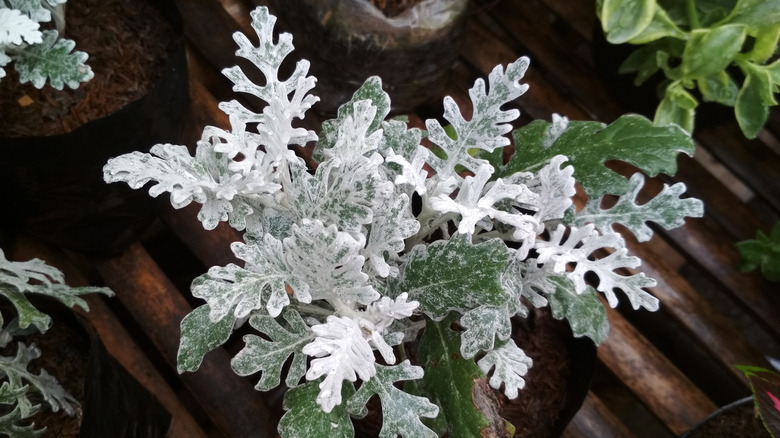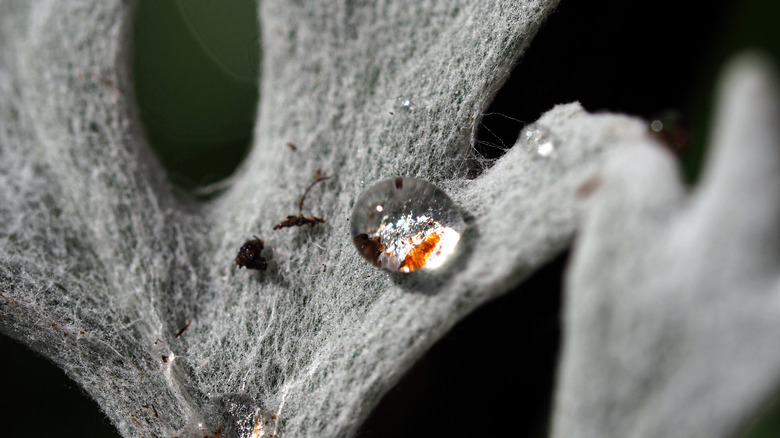How To Grow And Take Care Of A Dusty Miller Plant
Jacobaea maritima, formerly senecio cineraria, is more often known as the dusty miller plant, silver ragwort, or silver dust. They are native to the Mediterranean region, but they can be grown in many climates. Dusty miller plants do best in USDA hardiness zones 7 through 11 as perennials, and they are often grown as annuals in other climates, as per The Spruce.
The dusty miller plant is characterized by silvery-white leaves covered in fuzz and small yellow blooms. Its yellow flowers are not showy enough for most gardens, so they are often cut to help redirect the plant's energy to its prized foliage, according to Leafy Place. Whether you decide to plant your silver dust indoors or outdoors, it's unlikely to grow taller than 2 feet high. Many people prefer theirs even shorter and regularly prune it to keep the plant compact. Despite all this pruning, silver ragwort is quite easy to care for. It's tolerant of drought, heat, and neglect, and it is rarely bothered by pests.
How to use a dusty miller plant in the garden
Dusty miller plants are most often found in the garden and are less commonly used as houseplants. Their silvery foliage makes them great additions to any garden to bring out the colors of the flowers around them. Many people use these in their moon gardens since moonlight can reflect off of this plant's leaves so gracefully.
If you are thinking about including silver ragwort in your garden, try planting it as a border plant, mass planting, or among your favorite flower species or ornamental grasses. Jacobaea maritima make great companion plants to petunias, angelonias, basil, and zinnias. As stated by trees.com, dusty miller plants should be planted in full sun. They can easily grow in the shade, but they are the most beautiful when their leaves get at least eight hours of daily sunlight. Though this plant is said to only live in warm climates, some report their silver ragwort withstanding freezing zone 5 winters, explains The Spruce. Try not to let your climate dissuade you from nurturing this unique shrub. In the worst-case scenario, you can always replant it in the spring.
How to grow a dusty miller plant
Dusty miller plants can be grown in two ways: from seeds or cuttings. Buying a young jacobaea maritima from your local nursery is an alternate option if you don't want to wait as long to plant it. To grow a dusty miller plant from seeds, you'll need well-draining soil and a packet of jacobaea maritima seeds. Plant them in a tray filled with the soil ten weeks before the last predicted frost in your area. According to Trees.com, the seeds will need plenty of light so they can germinate. Do not cover the seeds with soil. Simply keep the seeds moist in a bright window. After two or three weeks, your seeds should sprout. Wait another few weeks until they are at least 2 inches tall before transplanting the silver dust seedlings into your garden.
Propagating dusty miller plants from cuttings is just as easy. Leafy Place suggests you start by cutting a 6-inch stem from a mature jacobaea maritima. Then, cut the lower leaves off your stem and dip the end into a rooting hormone. With your finger, press a small hole into a pot of moist soil. Place the stem into it and firm the soil around the stem with your fingers to keep it upright. Leave the pot and the stem in a bright window and check your cutting regularly for new growth. Once new leaves have grown, you can transplant the propagated dusty miller plant into your garden.
How to care for a dusty miller plant
If you are looking for another low-maintenance plant to add to your collection, the dusty miller plant is for you. This plant is known to be very easy to grow. It thrives indoors and outdoors, in full sun and the shade, and it is drought tolerant. It is very difficult to kill silver dust. To get the most out of your dusty miller plant, place it in an area where it will get plenty of sunlight. The more direct sunlight it gets, the more silvery its foliage will be, as per Better Homes & Gardens. You don't need to fertilize jacobaea maritima unless it is planted in poor soil. Instead of using all-purpose or liquid fertilizer, feed the plant with a compost mix, leaf mold, or rotted manure.
The watering schedule for the dusty miller plant is what you'll want to pay attention to the most. This is a shrub that does not need much water to survive. Too much water can lead to root rot as well as other problems. Silver ragwort should only be watered once per week with about an inch of water, as explained by The Spruce. Don't get too worked up if you miss a watering here and there because this drought-tolerant plant will be just fine.
Dusty miller plant varieties
Within the jacobaea genus, there are 64 species, according to Royal Botanic Gardens KEW. Native to the continents of Europe and Asia, as well as some parts of North America and Africa, dusty miller plants grow in various conditions, making them very popular as garden plants. Due to their popularity, they have been cultivated by botanists who found several interesting varieties, as told by Home Stratosphere.
-
"Silver Lace" is a variety of jacobaea maritima with delicate, fern-like leaves. It grows much smaller than your typical dusty miller plant, reaching only 8 inches tall during adulthood.
-
"New Look" has larger, round foliage and thick stems. This variety loves being pruned and propagated, only growing thicker when its foliage is cut.
-
"Ramparts" is the easiest type of dusty miller plant to grow. It only needs very basic care to continue living in your garden.
-
"Cirrus" has a cool look with wide serrated leaves that are extra silvery. You might choose this variety over the others because it has a lifespan of longer than eight years.
-
"Silver Dust" is a variety that can appear even more silverly than other cultivars. It's a happy plant great for planting in containers or used as border plantings.
Are dusty miller plants toxic?
Jacobaea maritima is toxic to pets and humans, as warned by Leafy Place. The plant's leaves contain pyrrolizidine alkaloids. When ingested, these can cause a range of symptoms in humans, pets, and other domestic animals such as pigs, sheep, and horses. The symptoms which follow ingestion of pyrrolizidine alkaloids may include liver failure, dizziness, weight loss, vomiting, diarrhea, and more, as explained by the ASPCA.
You should watch children and pets around your silver ragwort to ensure their safety. If you keep your silver ragwort inside your home, make sure it is far from their reach. While the leaves are not tasty, pets and children may still get into the plant out of curiosity. You should also be careful when gardening with the dusty miller plant as its sap can be dangerous. Getting this plant's sap on your skin can lead to an allergic reaction, dermatitis, or worse, if the skin is broken. Always wear gloves when working with this plant to avoid its toxins.
How to repot a dusty miller plant
Your dusty miller plant won't need to be repotted often. There is no exact timeline for when you should repot this plant. Simply watch its drainage hole, and repot when the roots are peeking out, as per The Spruce. When you are ready to repot, make sure you have well-draining soil and a new pot that is at least 2 inches bigger than the last on hand.
To repot, grab your plant from the base and flip the pot to dislodge it. If you are struggling to get it out, carefully run a flat tool along where the soil meets the pot to help it unseat. Then, break up the dirt on its base to expose its root ball. Do this gently so as not to rip any of the plant's roots. Once some of the excess dirt has been shaken out, replant the silver dust into its new pot with fresh soil unless your plant's potting soil is still new, as shown in this video by Creative Home & Garden. Pack the dirt on top of the plant's roots to ensure it is secure in its container. Finally, moisten the soil and place its pot in a sunny area of your choice.
The dusty miller plant's common pests and problems
Dusty miller plants are unaffected by most pests, but not all. According to Leafy Place, slugs and aphids are about the only pests that may bother this plant. Slugs can be prevented as long as you keep the area around your plant mostly dry. You can deal with slugs by merely picking them up and moving them elsewhere. Alternatively, you can set traps for them if the idea of moving slugs by hand makes you uncomfortable. Aphids are just as easy to get rid of. If you notice these tiny creatures, spray your plants' leaves with neem oil or an insecticide solution to kill and deter them.
Silver ragwort is rarely affected by diseases as well. Powdery mildew and root rot are the only problems you should worry about. Both of these plant diseases are caused by overwatering. If you notice its leaves turning yellow and wilting, cut back on your watering schedule and assess the soil. If water retention is a problem in your garden, your plant may need to be moved to a location where water can drain out properly.
